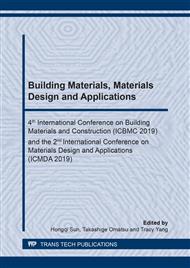[1]
A.G. Tamrazyan, L.A. Avetisyan: Experimental and Theoretical Study of Reinforced Concrete Elements under Different Characteristics of Loading at High Temperatures. Procedia Engineering, 153 (2016), pp.721-725.
DOI: 10.1016/j.proeng.2016.08.232
Google Scholar
[2]
O.V. Kabantsev, A.G. Tamrazian: Allowing for changes in the calculated scheme during the analysis of structural behavior. (2014) Magazine of Civil Engineering, 49(5) (2014), pp.15-26.
DOI: 10.5862/mce.49.2
Google Scholar
[3]
A. Tamrazyan, E. Filimonova: Searching method of optimization of bending reinforced concrete slabs with simultaneous assessment of criterion function and the boundary conditions. Applied Mechanics and Materials, 467 (2014), pp.404-409.
DOI: 10.4028/www.scientific.net/amm.467.404
Google Scholar
[4]
B.S. Rastorguev: On the question of the application of indirect reinforcement in the crossbars of multi-storey industrial buildings. News from Universities: Construction and Architecture, 9 (1985), pp.1-4.
Google Scholar
[5]
A.L. Krishan: Strength calculation of compressed reinforced concrete elements with indirect reinforcement with nets. Architecture Building Education, 1(3) (2014), pp.215-224.
Google Scholar
[6]
V.I. Gnedovsky: Indirect reinforcement of reinforced concrete structures (Stroyizdat, Leningrad, USSR 1981).
Google Scholar
[7]
G.M. Martirosov: Improving the efficiency of indirect reinforcement. Concrete and Reinforced Concrete, 9 (1980), pp.12-13.
Google Scholar
[8]
L.I. Storozhenko: Efficiency of compressed elements with various methods of reinforcement. News from Universities: Construction and Architecture, 6 (1981), pp.26-29.
Google Scholar
[9]
B.S. Rastorguev: Calculation of reinforced concrete elements with cross-mesh reinforcement. Industrial and Civil Construction, 10 (2009), pp.53-54.
Google Scholar
[10]
M. Attard: A stress–strain model for uniaxial and confined concrete under compression. Engineering Structure, 41 (2012), pp.335-349.
DOI: 10.1016/j.engstruct.2012.03.027
Google Scholar
[11]
D.C. Kent, R. Park: Flexural Members with Confined Concrete. Journal of the Structural Division: ASCE, 97(7) (1971), pp.1969-1990.
DOI: 10.1061/jsdeag.0002957
Google Scholar
[12]
S.A. Sheikh, S.M. Uzumeri: Analytical Model for Concrete Confinement in Tied Columns. Journal of the Structural Division: ASCE, 108(12), (1982), pp.2703-2722.
DOI: 10.1061/jsdeag.0006100
Google Scholar
[13]
J.B. Mander: Theoretical Stress-Strain Model for Confined Concrete. Journal of the Structural Division: ASCE, 114(8) (1988), pp.1804-1825.
Google Scholar
[14]
A.G. Tamrazyan: Calculation of flat reinforced concrete floors, taking into account the actual stiffness of the section. Scientific Review, 8 (2015), pp.87-92.
Google Scholar
[15]
SP 63.13330.2012. Concrete and Reinforced Concrete Structures. The main provisions. Updated edition of SNiP 52-01-2003 (Ministry of Regional Development of the Russian Federation, Moscow, Russia 2011).
Google Scholar
[16]
K.K. Bakirov: The bearing capacity of compressed reinforced concrete elements of rectangular cross-section with indirect reinforcement in the form of grids (with a short-term load action) (PhD Thesis, Moscow Institute of Civil Engineering, Moscow, USSR 1976).
Google Scholar
[17]
N.I. Karpenko: General models of reinforced concrete mechanics (Stroyizdat, Moscow, Russia 1996).
Google Scholar
[18]
N.G. Matkov: About the deformation diagrams of compressible reinforced concrete elements with longitudinal and transverse reinforcement – Improvement of methods for calculating statically indefinable elements of reinforced concrete structures (Research Institute of Concrete and Reinforced Concrete NIIZB, Moscow, USSR 1987).
DOI: 10.14359/5674
Google Scholar


